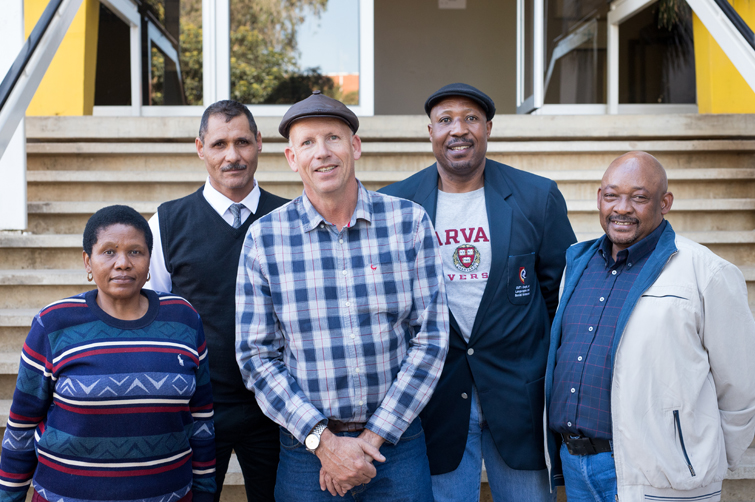Latest News Archive
Please select Category, Year, and then Month to display items
13 January 2020
|
Story Eugene Seegers
|
Photo Anja Aucamp
 Spearheading the digital expansion of the conversational Sesotho course is IDEAS Lab Director, Johann Möller (middle). With him are from the left: Prof Pule Phindane, CUT; Dr Brenton Fredericks, CUT; Bahedile Letlala, UFS Department of African Languages; and Dr Elias Malete, UFS Department of African Languages.
Spearheading the digital expansion of the conversational Sesotho course is IDEAS Lab Director, Johann Möller (middle). With him are from the left: Prof Pule Phindane, CUT; Dr Brenton Fredericks, CUT; Bahedile Letlala, UFS Department of African Languages; and Dr Elias Malete, UFS Department of African Languages.
For many years now, the UFS has been offering a one-year course in conversational Sesotho for staff members; this can then be followed up with the one-year course in advanced conversational Sesotho. The conversational Sesotho for students in the Faculty of Education was introduced in 2018 at the UFS.
The Central University of Technology (CUT) needed a conversational course for its first-year students and approached the Department of African Languages for the development of such a course. Living as we do in a multilingual country; this additional language skill opens doors and often hearts as well.
Using instructional design principles
However, the need was identified by both CUT and UFS to present this crucial information in a way that would be more appealing to digital natives as well as to those less familiar with technology. The Department of African Languages on the UFS Bloemfontein Campus, together with relevant departments from the CUT, approached the IDEAS Lab located on the UFS South Campus, since they already have a reputation for being a specialist on broadcasting and repackaging curricular content for digital presentations. The IDEAS Lab provided technical advice and built the multimedia programme, which will help the user to hear and practice phrases in Sesotho, using instructional design principles. The course will be available to both staff and students belonging to the two universities.
Room for growth
Johann Möller, Director of the IDEAS Lab, says this pilot programme will give both institutions the opportunity to test the use of multimedia for language acquisition. He adds, “Language is extremely complex, and we would like to expand this learning aid in the future.” In fact, the original design has room for growth built into it.
To keep things simple for the user and the building team, it was decided to start out with only four potential everyday scenarios where a staff member would like to speak Sesotho: Firstly, how to greet other persons from different genders; secondly, potential scenarios one might encounter in the university environment itself; thirdly, how to deal with situations at a hospital; and finally, how to use one’s language skills at a filling station.
Pronunciation is key
Each scenario contains three to four conversations that the learner can revise, along with images and audio that illustrate the situation and assist with correct pronunciation. The system does not allow the user to progress unless they have listened to the pronunciations of the sample sentences or phrases.
Further reading material and vocabulary lists are also provided, with the result that people who are using the programme can learn at their own pace. The authoring software Articulate Storyline was used to build the individual scenarios and each conversation or lesson within it. The lessons are also not dependent on an internet connection; they can be downloaded onto a flash memory drive and used offline.
Student represents UFS and SA in world orchestra
2015-11-27

The A-list violist, Maja van Dyk
|
Among the 100 musicians from 74 countries who performed at the Carnegie Hall in New York as part of the International Youth Philharmonic Orchestra (YPHIL) tour was Maja van Dyk. The viola player was one of two South Africans, and the only University of the Free State (UFS) representative, in the main performance of the tour on 27 September 2015.
“The highlight of the tour was definitely the concert in Carnegie Hall,” said Maja.
The fourth-year BMus student at the UFS Odeion School of Music (OSM) was one of 900 musicians between 18 and 26 years of age who auditioned for the world orchestra. She reached a major milestone in her music career when she was selected as both our country and our university’s ambassador.
The YPHIL project is a hub for the most powerful young performers from all over the world who spotlight social issues affecting the global collective through music. This objective behind creating one symphonic voice is to unite and empower in an unconventional manner.
Over the years, Maja has gathered a wealth of experience by playing for the MIAGI Youth Orchestra, the South African National Youth Orchestra, the Free State Youth Orchestra, the OSM Camerata, and the Free State Symphony Orchestra, as well as the Bloemfontein and Stellenbosch City Orchestras.
As a member of the National Youth Orchestra, she was invited to tour the country with the world-class Zurich Chamber Orchestra and the Zürcher Kammerorchester in 2012 and 2013 respectively. Her recent international exposure cannot be separated from past stints on the world stage. “I participated in tours of The World Orchestra to Spain and Lebanon, prior to the YPhil tour to New York City this past September,” she said.
The award-winning Maja is currently playing as an ad hoc member for the Cape Town Philharmonic Orchestra. She moved to the Western Cape after she played in her last exam last week.